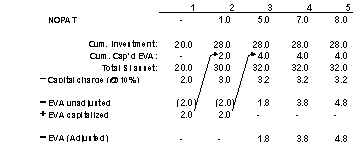Option 3a - Capitalize all early year EVA losses and their carrying cost

Note that EP/EVA is zero during the two year capitalization period. In this case, the amount capitalized was less than the capital charge on SI asset, but the effect of this Example 2 versus Example 1a is not pronounced. However, some investments will be by actual operating losses that may be significant before they decline and turn into profits.
<
Benefit
This treatment will leave managers perfectly EP/EVA neutral during the "ramp-up" period. Other considerations will remain the same as for Option 3, such as the capitalization only of planned EP losses (not actual), the timing for bringing SI assets out of the capital suspense account and into the business unit capital base, and establishment of thresholds or procedures for considering strategic investments for special treatment
Drawback.
The main drawback of this option versus Option 3 is the need to track not just the investment in a capital suspense account, but the entire EP being capitalized. That requires knowing project income that, as noted earlier, can be a tricky number to isolate. However, since the recommended course of action is to capitalize planned EP losses instead of actual losses, once the treatment has been approved for the project and the project is underway, you wont need to know actual project income at all (at least, not for reporting purposes. There may be other managerial reasons to try to obtain and track this figure).
From a valuation perspective, it doesn't really matter on what basis the suspense account is established and utilized. Behaviorally, whether we are capitalizing the capital charge on the investment or the EP losses is not the critical factor in the usefulness of this adjustment. What matters is the reduction of a near-term EP dilution that would occur if certain investments were undertaken. If managers claim that capitalizing only half of the losses would be good enough to get them to invest, then that's all that needs to be capitalized. The key, again, is the discipline to not allow SI assets to bloat up or to dwell too long in the capital suspense account.